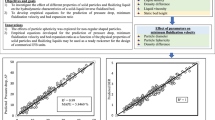Abstract
The numerical exercise of two subprocesses—attachment and detachment of air bubble and mineral particle—illustrates feasibility of 2–3 times improvement of concentrate quality in separate flotation of sand and fine material as compared to the standard processing. This effect is achieved owing to optimization of ratio of bubble diameter and dissipation energy for each out of 36 fractions of particles differing in size and content of copper. The relationship of hydrodynamic factors depends on the size of the particles and on the distribution of metal in them.
Similar content being viewed by others
References
Kurmaev, R.Kh., Flotatsionnyi metod polucheniya khloristogo kaliya (Potassium Chloride Production by Flotation), Ekaterinburg: UGTU–UPI, 1995.
http://wwwsevdorcom/cetcoru/departments/coal.
Kozlov, V.A. and Novak, V.I., Column Flotation in Coal Industry, GIAB, 2011, no. 4.
Rulyov, N.N., Turbulent Microflotation of Ultrafine Minerals, Mineral Processing and Extractive Metallurgy, 2008. vol. 117, no. 1.
Jameson, G.J., New Directions in Flotation Machine Design, Minerals Engineering, 2010. vol. 23.
Samygin, V.D. and Grigor’ev, P.V., Modeling Hydrodynamic Effect on Flotation Selectivity. Part I: Air Bubble Diameter and Turbulent Dissipation Energy, J. Min. Sci., 2015, vol. 51, no. 1, pp. 157–163.
Goryachev, B.Y., Nikolaev, A.B., and Il’ina, Y., Analysis of Flotation Kinetics of Particles with the Controllable Hydrophobic Behavior, J. Min. Sci., 2010, vol. 46, no. 1, pp. 72–77.
Koh, P.T.L. and Schwarts, M.P., CFD Modelling of Bubble–Particle Attachments in Flotation Cells, Minerals Engineering, 2006. vol. 19.
Yoon, R.H. and Luttrell, G.H., The Effect of Bubble Size on Fine Particle Flotation, Mineral Processing and Extractive Metallurgy Review, 1989. vol. 5.
Dai, Z., Fornasiero, D., and Ralston, J., Particle–Bubble Attachment in Mineral Flotation, Journal Colloid and Interface Science, 1999. vol. 217, no. 1.
Schulze, H.J., Hydrodynamics of Bubble–Mineral Particle Collisions, Mineral Processing and Extractive Metallurgy Review, 1989. vol. 5.
Kostoglou, M., Thodoris, D., Karapantsios, A., Kostas, A., Matis, M., et al., Modeling Local Flotation Frequency in a Turbulent Flow Field, Advances in Colloid and Interface Science, 2006, no. 122.
Koh, P.T.L., Manickam, M., and Schwarts, M.P., CFD Simulation of Particle–Bubble Collisions in Mineral Flotation Cells, Minerals Engineering, 2000, no. 13.
Bourke, P., Optimizing Large Flotation Cell Hydrodynamics Using CFD, Output Australia, 2007, no. 19.
Linch, A.J. and Rao, T.C., Modelling and Scale-Up of the Hydrocyclone Classifiers XI, J.M.P.S, 1975.
Kondrat’ev, S.A. and Izotov, A.S., Influence of Bubble Oscillations on the Strength of Particle Adhesion with an Accounting for the Physical and Chemical Conditions of Flotation, J. Min. Sci., 1998, vol. 34, no. 5, pp. 459–465.
Kondrat’ev, S.A., Effect of Apolar Reagents and Surfactants on the Stability of a Flotation Complex, J. Min. Sci., 2000, vol. 36, no. 4, pp. 399–407.
Author information
Authors and Affiliations
Corresponding author
Additional information
Original Russian Text © V.D. Samygin, P.V. Grigor’ev, 2015, published in Fiziko-Tekhnicheskie Problemy Razrabotki Poleznykh Iskopaemykh, 2015, No. 2, pp. 161–166.
Rights and permissions
About this article
Cite this article
Samygin, V.D., Grigor’ev, P.V. Modeling hydrodynamic effect on flotation selectivity. Part II: Influence of initial feed separation into large and small fractions. J Min Sci 51, 374–379 (2015). https://doi.org/10.1134/S1062739115020234
Received:
Published:
Issue Date:
DOI: https://doi.org/10.1134/S1062739115020234



